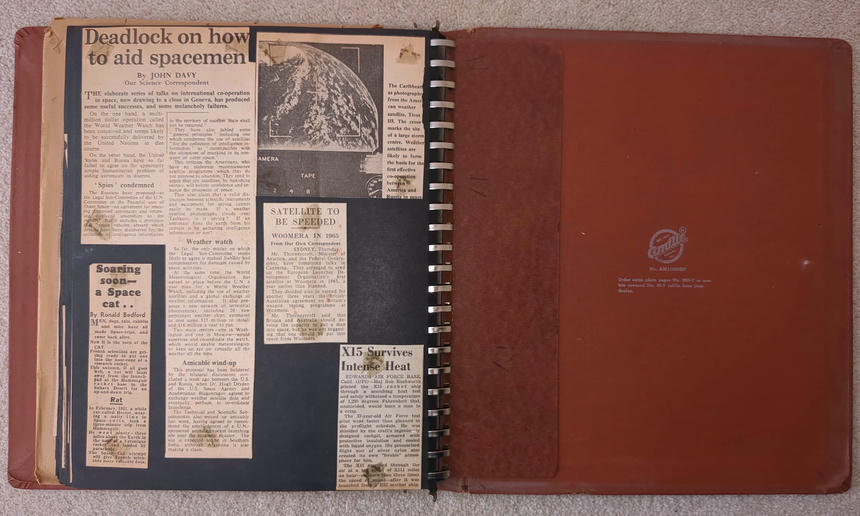Scrapbook 1: 1963? — Cooperation, space cat, X-15

Deadlock on how to aid spacemen
By JOHN DAVY Our Science Correspondent
THE elaborate series of talks on international co-operation in space, now drawing to a close in Geneva, has produced some useful successes, and some melancholy failures.
On the one hand, a multi-million dollar operation called the World Weather Watch has been conceived and seems likely to be successfully delivered by the United Nations in due course.
On the other hand, the United States and Russia have so far failed to agree on the apparently simple humanitarian problem of aiding astronauts in distress.
‘Spies’ condemned
The Russians have proposed—to the Legal Sub-Committee of the U.N. Committee on the Peaceful uses of Outer Space—an agreement for rescuing distressed astronauts and returning displaced spaceships to the owners. But it includes a provision that “space vehicles aboard which devices have been discovered for the collection of intelligence information in the territory of another State shall not be returned.”
They have also tabled some “general principles” including one which condemns the use of satellites “for the collection of intelligence information” as “incompatible with the objectives of mankind in its conquest of outer space.”
This irritates the Americans, who have an elaborate reconnaissance satellite programme which they do not propose to abandon. They tend to argue that spy satellites, by banishing secrecy, will bolster confidence and enhance the prospects of peace.
They also claim that a valid distinction between scientific instruments and equipment for spying cannot easily be made. If a weather satellite photographs clouds over Tashkent, is it spying? If an astronaut films the earth from his capsule is he gathering intelligence information or not?
Weather watch
So far, the only matter on which the Legal Sub-Committee seems likely to agree is mutual liability and compensation for damages caused by space activities.
At the same time, the World Meteorological Organisation has agreed to place before the U.N. a vast plan for a World Weather Watch, including the use of weather satellites and a global exchange of weather information. It also proposes a new network of terrestrial observatories, including 20 new permanent weather ships, estimated to cost some $35 million to install and $16 million a year to run.
Two main centres—one in Washington and one in Moscow—would supervise and co-ordinate the watch, which would enable meteorologists to keep an eye on virtually all the weather all the time.
Amicable wind-up
This proposal has been bolstered by the bilateral discussions concluded a week ago between the U.S. and Russia, when Dr. Hugh Dryden of the U.S. Space Agency and Academician Blagonragov agreed to exchange weather satellite data and eventually, perhaps, to co-ordinate launchings.
The Technical and Scientific Subcommittee also wound up amicably last week, having agreed to recommend the establishment of a U.N.-sponsored sounding-rocket launching site near the magnetic equator. The site is expected to be in Southern India, although Argentina is also making a claim.
Soaring soon—a Space cat . .
By Ronald Bedford
MEN, dogs, rats, rabbits and mice have all made Space-trips, and come back alive.
Now it is the turn of the CAT.
French scientists are getting ready to put one into the nose-cone of a research rocket.
This autumn, if all goes well, a cat will blast away from the launchpad at the Hammaguir rocket base in the Sahara Desert for an up-and-down trip.
Rat
In February, 1961, a white rat called Hector, wearing a natty line in Space-suits, took a three-minute trip from Hammaguir.
He went ninety-three miles above the Earth In the nose of a Veronique rocket, and landed by parachute.
The Space-Cat attempt will give French scienlists more valuable data.
NOTE: Félicette, launched in October 1963.
The Caribbean as photographed from the American weather satellite, Tiros III. The cross marks the site of a large storm centre. Weather satellites are likely to form the basis for the first effective co-operation between America and Russia in space.
SATELLITE TO BE SPEEDED
WOOMERA IN 1965
From Our Own Correspondent SYDNEY, Thursday.
Mr. Thorneycroft, Minister of Aviation, and the Federal Government, have completed talks in Canberra. They arranged to send up the European Launcher Development Organisation’s first satellite at Woomera in 1965, a year earlier than planned.
They decided also to extend for another three years the British-Australian agreement on Britain’s weapon testing programme at Woomera.
Mr. Thorneycroft said that Britain and Australia should develop the capacity to put a man into space, but he was not suggesting that one should be put into space from Woomera.
X15 Survives Intense Heat
EDWARDS AIR FORCE BASE, Calif. (UPI)—Maj Bob Rushworth piloted the X15 rocket ship through a scorching heat test and safely withstood a temperature of 1,250 degrees Fahrenheit that, unshielded, would burn a man to a crisp.
The 37-year-old Air Force test pilot went faster than planned in the preflight schedule. He was shielded by the craft’s ingeniously designed cockpit, armored with protective insulation and cooled with liquid oxygen. His pressurized flight suit of silver nylon also created its own “livable” atmosphere for him.
The X15 scorched through the air at a top speed of 3,511 miles an hour—or more than three times the speed of sound—after it was launched from a B52 mother ship.